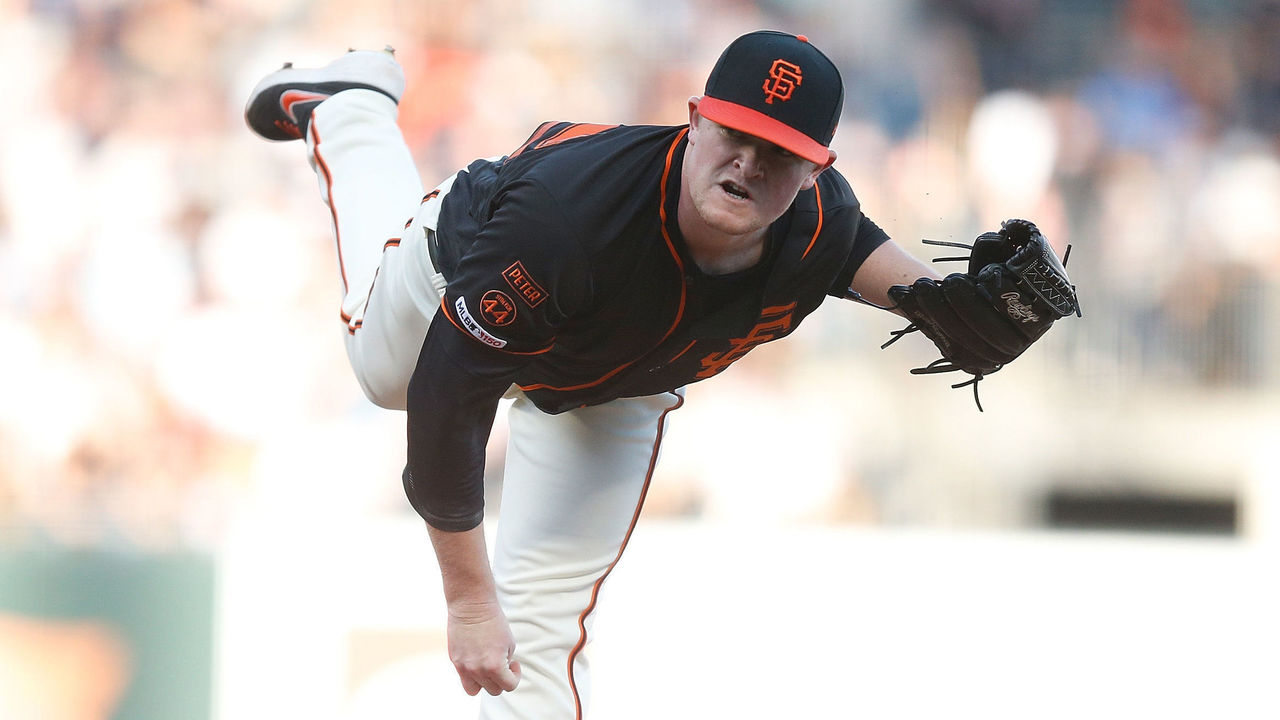New arm slot, new magic: On Logan Webb's reinvention
Shortly after Christmas in 2019, Logan Webb got a call from Brian Bannister, the former major-league pitcher, who the San Francisco Giants had just hired to fill a new-age role titled "vice president of pitching development." Bannister was tasked with working with Giants pitchers and coaches to build the best possible deliveries and pitches for all the arms in the system.
After some brief introductory small talk, Webb was quickly taken aback by the message.
"Maybe 45 seconds into the call, he’s talking about how I'm going to change arm slots," Webb told theScore earlier this season. "Forty-five seconds in and you want me to switch everything I've done?"
Prior to hiring Bannister, Giants coaches were working with Webb on refining his four-seam fastball, his primary offering. They wanted him to pitch more effectively with it at the top of the zone, and also wanted him to add a cutter to play off it. (In the Statcast era, elevated four-seamers are an en vogue pitch designed to get swing and miss above uppercut swings.) That experiment was now over, and Bannister recommended Webb do something completely different.

At the time, Webb was coming off his first partial season in the majors - a season of struggles. He was hit hard in his first 39 innings, posting a 5.22 ERA. As he digested Bannister's message and plan, Webb became open to it.
The story of Webb's ascension to the top of a major-league rotation, where the Giants need him to keep pitching well to try and jump back into the wild-card race, is a story about individualized development. The idea that there are one-size-fits-all organization philosophies in how or what to throw are over. The Giants build upon an individual's strength. And what Webb did so naturally well after an adjustment has allowed him to ride the wave of one of baseball's great breakthroughs in pitching science, one that in December 2019 even the Giants didn't see coming.
A few weeks after the call, Webb reported to spring training and began working on the Giants' plan for him.
"They literally told me to throw sidearm," Webb said.
Bannister shared with Webb video of Chris Sale's motion; Bannister was familiar with the lefty ace from his time in Boston. The goal was for Webb to throw nearer to Sale's low arm slot. So in the sun-soaked Arizona bullpens, Webb started dropping down with little initial instruction other than to throw lower and find something that felt comfortable.
Watching over the project was then first-year pitching coach Andrew Bailey. Bailey and the Giants staff felt Webb should embrace his "unique" athletic movements and be more rotational than direct to home plate in his delivery.

"When I first came on, Logan was a prospect with some big-league time and he really didn't understand himself as a mover, as a pitcher, what he was trying to do - and it's a scary place," Bailey told theScore. "You start to struggle, you get internally focused on some delivery stuff. You don't have a foundation."
Rather than burden Webb with too much information, Bailey focused on a few cues about timing and throwing motion.
Webb's vertical release - how high a pitcher releases the ball above the ground - dropped from 5.58 feet in 2019 to an average of 4.99 feet over the last two seasons. Of 463 pitchers to qualify over those time periods, only A.J. Puk and Javy Guerra lowered their arm slots more.
The arm slot change was key because Webb was going to alter what he threw out of it.
Instead of four-seamers, Webb was to only throw two-seamers, which the Giants felt was a better pitch in terms of movement profile. While sinkers had fallen out of fashion with many pitchers, Webb was reminded: not too long ago, Jake Arrieta won a Cy Young Award with the Chicago Cubs by relying on a sinker-slider mix.
Even in long toss and in catch with teammates, Webb was to throw with only a two-seam grip - no four-seamers. That was the message from Bannister and Bailey. His right index finger and middle fingers were to go along with the seams, not run perpendicular to them. They were going to still try and miss bats, of course, but ground balls were great, too.
Webb had thrown two-seamers before in the minors, when his elbow started to hurt, but after Tommy John surgery he added velocity and the Giants thought he should switch to a four-seamer. The truth, though, was that he never quite felt comfortable trying to be an up-in-the-zone, four-seam pitcher. Perhaps this would feel more natural.

But then COVID hit, shutting camps down. While play eventually resumed in the summer, Webb's performance was uneven in a shortened Year 1 of his new self. He struggled to command the ball, but there was a silver lining: all his pitches - his two-seamer, slider, and changeup - picked up movement, and the gains couldn't be explained by spin-based movement.
Webb and Giants were tapping into something new.
Spin governs much of pitch movement. A force known as Magnus Effect makes a curveball curve and a fastball appear to rise. In 1852, German physicist Gustav Magnus was perplexed why cannonballs fired out of smooth-bore barrels often curved in unpredictable ways. He discovered that a sphere spinning through air will drag air around with it, creating a pressure differential. The shell moves toward the area of lower pressure.
Rifled barrels fixed the accuracy issues by creating a different type of spin: gyroscopic. It's the same kind of spin that's produced when a football is thrown in a spiral. Such spin is immune from Magnus Effect. (Most pitches thrown have an element of each type of spin, as the axis that the ball spins around is generally not perfectly in line to be 100% governed by Magnus or gyro spin.)
Those types of spins and their influence on projectiles have been known since the 19th century. More recently, a couple of college professors began considering another type of force governing movement not tied to spin, and their discoveries came just in time for Webb.
In 2012, University of Sydney physics professor Rod Cross published a paper and recorded a YouTube video demonstrating another way to make a ball move, separate from Magnus Effect: by creating pressure differentials via how seams were orientated on the ball, resulting in smooth and rough areas on the ball.
He included a pitch from a 2011 game as evidence, in which Freddy Garcia threw a split-fingered fastball that moved the opposite way that Magnus force suggested it should.
Cross called the effect "a little bit of magic."
The YouTube video made the rounds in nerdy baseball coaching circles. What if there was a new type of spin to move pitches in new ways? But aside from then-outsider facilities like Driveline Baseball in the mid 2010s, the idea struggled to gain traction.
Until Utah State mechanical and aerospace professor Barton Smith dove deeper into it.
Smith's son was pitching in youth baseball, and Smith asked someone why four- and two-seamers move differently. No one seemed to have a good answer, so he started investigating. While Cross didn't experiment with baseballs in game velocities or conditions, Smith and some of his students did.
They were curious to learn about how the seams in game-style ball flight interacted with the air passing around them. They experimented with baseballs being spit out of a pitching machine at 90 mph, with cameras and pitch-tracking tech watching. In the summer and fall of 2020, Smith and some of his graduate students published their findings.

Here's an excerpt from the abstract of student Andrew Smith's dissertation:
An examination of the airflow around a baseball led to the understanding that when seams are in certain areas on the baseball's surface the airflow changes. A subsequent experiment was performed which showed that when these changes in airflow were on one side of the baseball more than the other, the ball moved away from the side with the seams.
This type of movement didn't even have a name. It would be coined by Andrew Smith: "seam-shifted wake."
Many in baseball, including Giants coaches, were paying attention. How does Bailey explain the concept to his pitchers?
"If we're able to orient the seams appropriately through ball flight, there's some added movement we can tap into," Bailey said. "We can nail down that seam orientation. It makes the ball move a different way than hitters are used to seeing."
And it was certain types of pitches, thrown from certain arm slots, that generally benefited more from seam-shifted wake than others: sinkers, sliders, and changeups.
Webb threw all of them. Could the Giants tap into this force?
Logan Webb, 84mph Frisbee Slider. 🥏 pic.twitter.com/GU4aNNaihn
— Rob Friedman (@PitchingNinja) September 12, 2021
As Webb struggled to start Year 2 of his project in 2021, there was talk of him moving to the bullpen prior to his May 17 start at Cincinnati. He was still trying to get comfortable with the new motion and arsenal when he tweaked his shoulder during his pregame warmup.
He elected to try and pitch through the discomfort. As he walked to the dugout after warming up, he told himself to just have fun with it. He threw six shutout innings.
"I just wanted to go out there and prove I can stay healthy, throw strikes, and show the stuff that I can offer," Webb said. "I was just trying to have fun with it (that day). The rest is a blur."
Webb's been one of the best pitchers in the majors ever since that day, ranking eighth in FanGraphs WAR and 10th in ERA (2.86).
And he'd never heard the term "seam-shifted wake" until early that season.
"I didn't really know it until last year when I sat down with Bannister and Bailey and all those guys really pointed to me why my two-seam is moving the way it is, and why my changeup is the same way," Webb said.
The Giants taught Webb to be more consistent in generating seam effect. The seams on the two-seamer and changeup needed to be oriented in such a way that there was nearly always a seam presence on specific areas of the ball as it spun, and smooth areas elsewhere, creating an imbalance in air flow: turbulent air in one area, smoother air in another. They used high-speed cameras and other available tech to give Webb feedback.
"Everyone has thrown (a) sinker and thought, 'Oh man, how do I throw that again, that was gross?'" Bailey said. "Well, we do that by hitting that orientation eight times out of 10. That's when you tap into your Edgertronic (high-speed camera). How often can you do that? How repeatable is that, that's the teaching practice."
The feedback from high-speed cameras captured the good and poor releases in detail, showing how exactly Webb's fingertips influenced the spin axis and seam alignment. It helped guide the Giants and Webb in getting to the seam effect more often.
Webb's vertical sinker movement improved from 25 inches in 2019 to 27.2 inches in 2020, to 31.7 inches in 2021, and to a career best 34.6 inches in 2022. This year, his sinker is moving nine inches more than the average major league two-seamer. His changeup movement improved, too, from 38 inches of drop in 2019 to 41.6 last year and 41.9 this year.
"When you get that seam-shifted wake the right way, it comes out and at the last second: bang," Webb said. "When it's not, it's a little slower and gives the hitter a better chance."
For instance, Greg Maddux's comeback, two-seam fastball was likely benefiting from seam effects.
#TBT to 13 years ago when Greg Maddux got his 3,000th strikeout with his patented two-seamer. pic.twitter.com/5vULksgLKj
— MLB (@MLB) July 26, 2018
Professor Smith discussed further on a podcast: "Sometimes people say, 'Hey, nice curveball' when they threw a changeup. The reason they say that is (because) it's being forced downward … pushed down by the seam."
Webb captured this invisible force.
"I think the added movement Logan gets from his seam orientation is unique to himself," Bailey said. "I think there's a series of movers (in baseball) that fall into that bucket. Anatomically we cannot make changes, they're kinda unique to themselves. Some guys can acquire it, some guys cannot. … When a pitcher can acquire that for more than one pitch in his arsenal, it's really unique and a beautiful thing. You get outlier movement that hitters aren't used to seeing."
Last year, Webb struck out Juan Soto on a tailing sinker, calling it the best two-seamer he's ever thrown.
Logan Webb struck out three in the first inning, including Juan Soto. His sinker has some serious life tonight: pic.twitter.com/vs9jl5Nkt1
— Alex Pavlovic (@PavlovicNBCS) July 10, 2021
Giants TV announcer Mike Krukow said the look on Soto's face suggested he was thinking: "What the heck was that? This thing just exploded."
It caught the wake wave.
The effect isn't new to anyone in the game, it's just now understood.

"For me, it's late life," Bailey said of the seam-shifted effect. "If you see a sinker down and away, 'Oh man, that's late life.' For me, that's what seam effects are visually. 'Oh, that just dropped off a table.' That's the suck down that you are able to tap into from seam effects."
By the second half of last season, Webb's sinker became one of the best pitches in baseball, helping the Giants win 107 games. Webb was excellent in two starts in the NLDS against the rival Dodgers.
And the reinvention, the education, the magic of seam effects, it all started with a phone call and a willingness to try something new.
"It changed my career."
Travis Sawchik is theScore's senior baseball writer.